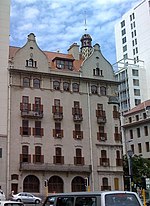Statue of George Grey
Buildings and structures in Cape Town

A statue of Sir George Grey stands in Company's Garden, in Cape Town, South Africa, in front of the local campus of the National Library of South Africa. The inscription on it reads "Sir George Grey K.C.B. Governor 1854–1861." Grey left his own personal library, the Grey Collection, to this library. William Calder Marshall from London completed the sculpture in 1863.
Excerpt from the Wikipedia article Statue of George Grey (License: CC BY-SA 3.0, Authors, Images).Statue of George Grey
Tuin Plein, Cape Town Cape Town Ward 115
Geographical coordinates (GPS) Address Nearby Places Show on map
Geographical coordinates (GPS)
| Latitude | Longitude |
|---|---|
| N -33.9256 ° | E 18.41853 ° |
Address
Company's Garden
Tuin Plein
8001 Cape Town, Cape Town Ward 115
Western Cape, South Africa
Open on Google Maps









